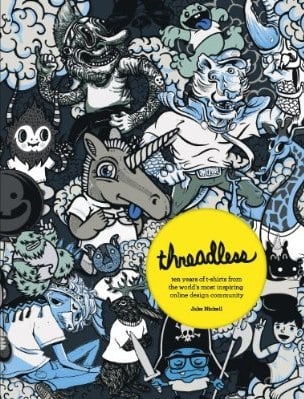 Threadless – everyone’s favorite T-shirt purveyor and example of crowdsourcing and customer community success – recently published a terrific 10th anniversary book that combines company history with dozens of its best designs. It makes for very interesting reading, and the production values and design elements make it a suitable coffee table book, and an excellent gift.
Threadless – everyone’s favorite T-shirt purveyor and example of crowdsourcing and customer community success – recently published a terrific 10th anniversary book that combines company history with dozens of its best designs. It makes for very interesting reading, and the production values and design elements make it a suitable coffee table book, and an excellent gift.
After devouring my review copy (thank you), I interviewed Jake Nickell, Threadless co-founder and author of the book, about the company, its unique culture, and what happens next.
Threadless the book is interesting because it’s half coffee table book of T-shirt designs, half business documentary. Unusual combination. How did you come up with that approach?
I can’t take credit for that one! The concept was mostly presented to us by the book packager we worked with on the book. We had been approached by publishers in the past to create a business book or an art book and none of it really felt right and also seemed like a TON of work to put together. So when the packager talked to us about this concept, we were all for it! They could help with the production work of the book, we could tell all the various angles of the Threadless story in this format and it was coming on our tenth anniversary too! The stars aligned and we got working.
It seems like Threadless doesn’t fear failure as much as many other companies. How do you describe the company’s view of experimentation?
From the very beginning we’ve always been very comfortable stepping outside of our comfort zone. When things got started we didn’t know how to screenprint tees, we didn’t know how to ship orders, we didn’t know how to charge credit cards. But we were confident in our ability to learn and figure out how to do those things. I’m personally really interested in learning new things so when a new challenge comes up I see it as an opportunity to learn something new rather than a wall or a hurdle.
How important is the culture of Threadless as a company to the success of the company, and as you’ve grown, how do you keep everyone on-board with the same values?
I think that the values that we have that have created the culture here are very important to the success. So now that we’re growing to the size that when new people are brought in, the culture can be very new, it’s just really important to make it clear what Threadless is all about. We have a mission statement to “Inspire Awesomeness” and we have a bunch of internal things that we do to help make sure everyone’s on the same page about it all. We do monthly awesome parties, host DIY days where anyone in the company can basically work on anything, anyone in the company can give anyone else in the company a bonus, etc… There are a ton of things we do!
As the community has grown, how have you had to scale your operations in social listening and engagement? I suspect you have more people monitoring Twitter, working on Facebook, interacting with the community in multiple places than you used to have. How do you know when it’s time to add resources in those areas?
Yea definitely. We really do this totally based on our gut feeling of how things are going within the community. Since so many of us working at Threadless also regularly participate within the community, it’s very easy for us to know what’s going on and be able to react to it immediately.
Charts and graphs are very useful for some things but I think in the case of really understanding your community, the very best thing you can do is be a real part of it.
Your Facebook page is consistently one of my favorites, because you really put the focus on the community, rather than on the company. Now, you’re selling shirts directly on Facebook. How is that working, and in general how do you view what you do on Facebook compared to what you do on Threadless.com?
Our shop tab on our Facebook page has been very successful. Facebook is definitely the best channel we have for connecting with our customers. I think it’s something like 5 websites that any person regularly visits, every day, so it’s important to try to be there too, on as many of those 5 websites you can be on. We treat Threadless on Facebook as just another place where we can go and interact with our community. Like we do our forum on Threadless.com, our Twitter account, etc.
I used CrowdSpring to design an e-book earlier this year. I was very happy with the outcome, but got slammed by several members of the design community that I was exploiting people because they submitted their designs for free, and I picked the one I liked, and that person got paid. How do you address that issue of “designers should get paid for their work regardless” within the Threadless submission community?
The difference on Threadless is that their work isn’t based on a spec. It’s just artwork on tees. So if their design isn’t chosen, it still has a purpose. They could sell it to someone else, print it themselves, use it for something other than a t-shirt, etc. My argument here is that an artist shouldn’t need to have a buyer before they create a painting, but a designer probably should have a buyer before they design a logo for someone. I do think there’s a place for both, we just try to stay on the other side of the issue as much as possible as we feel like the work is also a lot more interesting when it’s personal, not driven by our specifications.
A fascinating aspect of the book is to see the T-shirt styles change over time. Partially as a result of Threadless allowing more colors and bigger designs, but there are definitely design memes. Do you find design submissions change with the times? Are designs more exuberant when the economy is good, and more pessimistic when the economy sucks, for example?

I definitely see things change with the times. It’s been neat to see not only trends coming and going but also just the overall quality and level of detail and thought going into designs constantly increasing. I haven’t noticed much of a shift due to the economy but also haven’t really looked at that yet, very interesting thought!
What’s in the next 10 years for Threadless? Zappos talks about being a “customer service company” that just happens to sell apparel. Are you a “participation company” that just happens to sell apparel and other items with a design? Can the Threadless model be applied to other business types?
Yea, we feel that we are a “community based design” company that has found the t-shirt to be a very effective and easy to produce canvas over the past few years. We are looking to do more partnerships in the future with companies that have a product that could benefit from our design community and have the distribution to get that product out there in a meaningful way. We are also looking to be able to grow our t-shirt challenges with partnerships too, starting with Threadless Causes which will be launching shortly.
———–
Thanks very much to Jake for the insights, and for putting together a memorable and interesting book. Thanks also to Threadless for 10 years of inspiration.
For you, what’s the number one lesson businesses can learn from Threadless? The comments are yours.


